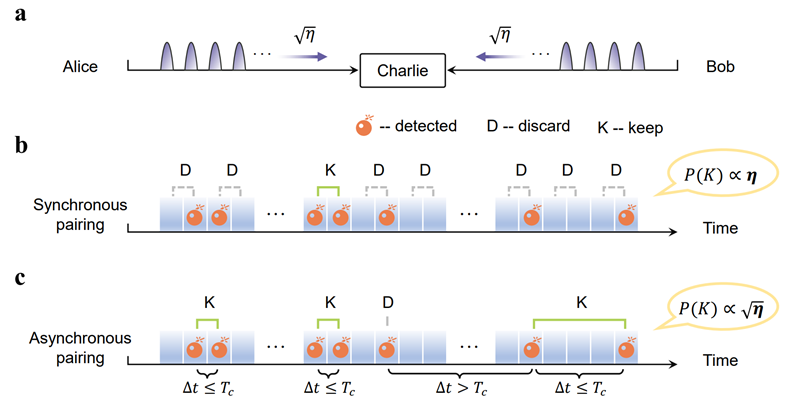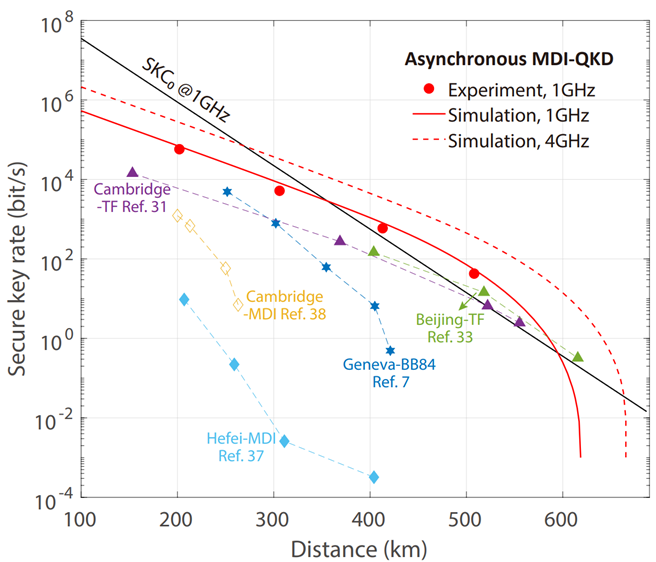Simplifying long-distance quantum communication
2022/06/22
Quantum Photonics Group of BAQIS, in collaboration with a team from Nanjing University, has recently published a research article entitled “Experimental quantum communication overcomes the rate-loss limit without global phase tracking” in the prestigious journal of Physical Review Letters, reporting a drastically simplified setup for long-distance quantum communication. This advance was featured in a Viewpoint article “Long-Range Quantum Cryptography Gets Simpler” in the APS Physics magazine.
Quantum key distribution (QKD) has emerged as a viable solution to mitigate the constant security threat posed by adversaries towards data communication networks. It exploits transmission of single photons for information exchange with security guaranteed by the laws of quantum mechanics. However, as a severe drawback, its information exchange rate or secure key rate (SKR) is subjected to the photon loss across the communication channel, dropping by 10-fold for every extra 50-km fiber added to the channel. Over 500 km distance, the SKR of a point-point QKD system will become prohibitively low for practical applications.
Recent breakthrough of twin-field (TF) QKD exploits a measurement node in the middle of the communication channel for halving the photon loss and can thus enable long-distance secure communication. However, TF-QKD’s implementation necessitates complex global phase tracking and requires strong phase references that not only add to noise but also reduce the duty cycle for quantum transmission. To resolve TF-QKD’s shortcomings but maintain its long-distance advantage, the team implemented an innovative but simpler measurement-device-independent (MDI) QKD that realizes repeater-like communication through post-measurement coincidence pairing (PMP).
Figure 1 sketches of the PMP concept. In a generic MDI-QKD setup, the communication users, Alice and Bob, send photons to Charlie, who performs two-photon interference and post-select valid two-photon coincidences for secure key generation. Here, Charlie’s photon detection probability is proportional to the transmittance of the half channel, i.e., √η . In conventional MDI-QKD schemes, only two photons arriving in adjacent time windows can be paired to form a legitimate coincidence and therefore the success rate is proportional to the transmittance of the entire communication channel, i.e., η . In the PMP scheme, Charlie can pair arbitrarily two photon detection events, as long as their temporal separation is less than the mutual coherence of Alice and Bob’s lasers, thereby improving the pairing success probability, and hence the SKR, to be proportional to √η . With fiber drift as the dominant decoherence source, the MDI-QKD system allows PMP over large time intervals of up to 200 μs. Over a lossy channel, e.g., of 100 dB loss, the improvement can amount to five orders of magnitude.

Figure 1 Schematics for MDI-QKD protocols. a, Generic MDI-QKD; Alice and Bob each sends a train of encoded weak coherent pulses to the intermediate node, Charlie, who performs the first-order interference using a 50/50 beam splitter (not shown). The transmittance of the entire quantum channel is denoted as η, so each user’s segment has √η transmittance. b, In conventioal time-bin MDI-QKD, a valid coincidence is registered only when two adjacent time bins registered a photon click each. Its coincidence probability is proportional to η, i.e., P(K) ∝ η. c, In PMP-QKD, Alice and Bob can pair photon clicks into a valid coincidence provided that their temporal separation is less than the mutual coherence time (Tc). When the click rate far exceeds 1/Tc, P(K) ∝√η.

Figure 2 Secure key rates (red dots) for the PMP-QKD. Green triangles are the SKRs obtain by the BAQIS group using TF-QKD protocol.
Figure 2 shows the SKRs (red dots) measured in the PMP-QKD system. Over 508 km optical fiber, the PMP-QKD system delivers a finite-size SKR of 42 bit/s. Significantly, the SKR at 306 km exceeds 5 kb/s and meets the bitrate requirement for live one-time-pad encryption of voice communication. Compared to TF-QKD, PMP-QKD offers similar repeater-like rate-loss scaling but has the advantage of not requiring global phase tracking. The team’s work will bring forward economical and efficient intercity quantum-secure networks.
Dr Lai Zhou, Associate Researcher at BAQIS, and Mr Jinping Lin, Engineer at BAQIS, and Miss Yuan-Mei Xie and Mr Yu-Shuo, both PhD students at Nanjing University contributed equally to this project. Dr Zhiliang Yuan, Chief Scientist at BAQIS, and Associate Professor Hua-Lei Yin of Nanjing University supervised the project. The project work received support from the National Natural Science Foundation of China, the Natural Science Foundation of Jiangsu Province, the Fundamental Research Funds for the Central Universities, and the Key Research and Development Program of Nanjing Jiangbei New Area.
Article link:https://journals.aps.org/prl/abstract/10.1103/PhysRevLett.130.250801
APS Viewpoint article link: https://physics.aps.org/articles/v16/104
 中文
中文 Email
Email QCloud
QCloud Log in
Log in
